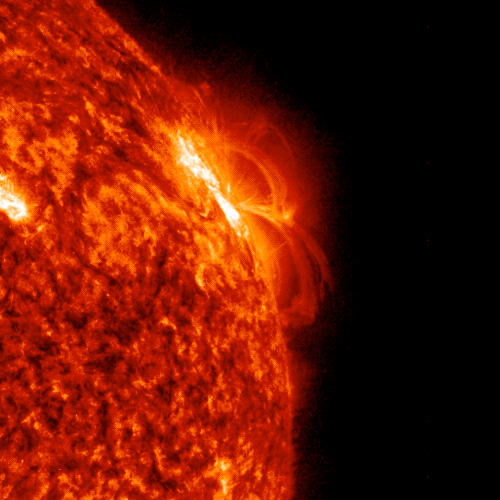Earth’s host star can be quite temperamental, compelling astronomers to launch satellites and probes on missions to keep a close watch of the Sun’s massive flares. But instruments pointed towards the Sun have a tendency to acquire cloudy vision as the result of a mysterious layer that’s puzzled scientists for years.
Instruments on board NASA’s Solar Dynamics Observatory (SDO), which has been observing the Sun since 2010, degraded by 40% within five years of its launch. Today, a group of scientists may have finally identified the culprit behind the spacecraft’s blurry outlook: water.
“Degradation of Sun-viewing satellites occurred before SDO had a problem…but the cause was unclear,” Robert Berg, a researcher at the U.S. National Institute of Standards and Technology (NIST), and one of the authors behind a new study published in Solar Physics, told Gizmodo in an email. Previous studies “named oxidation as one of several possible causes, but water was not proposed as the oxidant,” he added.
In order to crack the code, the scientists behind the new study used a room-sized particle accelerator to replicate the conditions imposed by space weather. They found that oxygen atoms from water molecules combined with the aluminium from a spacecraft’s instruments to produce a hazy layer of aluminium oxide that blocks incoming rays from the Sun.
In the new research published on Thursday, scientists from NIST and the University of Colorado Boulder’s Laboratory for Atmospheric and Space Physics detailed these important new findings. “We were not able to expose to years’ worth of radiation, but along with a model of oxide growth, we show pretty convincingly that water vapour with ultraviolet light could cause the observed losses,” Charles Tarrio, a physicist from NIST and lead author of the new study, explained in anemail.
Spacecraft observing the Sun use aluminium filters — each smaller than a postage stamp and thinner than human hair — to collect extreme ultraviolet light, a wavelength of light emitted by the Sun that is too short for the human eye to see. Although EUV makes up a small fraction of the total amount of light from the Sun, it plays a vital role in notifying scientists of when the star is about to have a flareup.
The Sun occasionally lets out bursts of energy known as coronal mass ejections — gigantic blasts of charged particles that extend away from the Sun like hot whips. These events can affect us here on Earth, resulting in geomagnetic storms that cause disruptions in power grids and navigation systems.

By monitoring the Sun with solar probes and satellites, scientists can get a better handle on its flareup schedule. Unfortunately, however, spacecraft that face the Sun tend to lose their ability to capture EUV light within a few years of entering into service. A spacecraft’s filter typically transmits about 50% of EUV light through its detector at the beginning of its mission, decreasing to 25% within one year and 10% within five years, according to NIST. The researchers based this on their study of SDO, but say that other spacecraft suffered the same fate.
Other examples of spacecraft degradation include the LYRA instrument on board the European PROBA2 satellite, the SOLSPEC instrument on board the SOLAR payload for the International Space Station, which was used to measure solar energy, and the Solar Diameter Imager and Surface Mapper telescope on board the PICARD spacecraft, according to Berg.
For years, scientists believed that the filters were developing a layer of carbon, a result of contamination on the spacecraft. But the same group of scientists behind the new research disproved that theory in 2021 before immediately going back to the drawing board. “The other thing that pointed toward oxidation is that the spacecraft instruments have been built to be cleaner and cleaner over the past few decades, with the goal of eliminating sources of organic molecules that lead to carbon deposition,” Tarrio said. “However, many instruments still show significant degradation. This points away from carbon growth.”
Using a particle accelerator to generate EUV light, the researchers diverted this light to the spacecraft filters using mirrors while also exposing them to water vapour. After 20 days, the filters developed a layer of aluminium oxide. The layer wasn’t thick enough to hinder the filters’ ability to capture EUV light, but it likely would’ve gotten even thicker over a longer period of time. The scientists also created theoretical models that agreed with what was happening to the spacecraft in real life.
So how did the oxide layer form in the first place? The scientists believe that water from the spacecraft’s thermal blanket, which is used to control the spacecraft’s temperature, interacts with the filter’s aluminium to produce the oxidized layer that then blocks the light from travelling through the detector.
The new research could better inform the design of future Sun-gazing spacecraft to help prevent their rapid degradation. One thing the researchers suggested was adding a layer of carbon to stop the movement of aluminium ions, as well as tubes that block incoming water vapour.
More: Sun-Orbiting Spacecraft Takes Fascinating Images of a Coronal Mass Ejection
